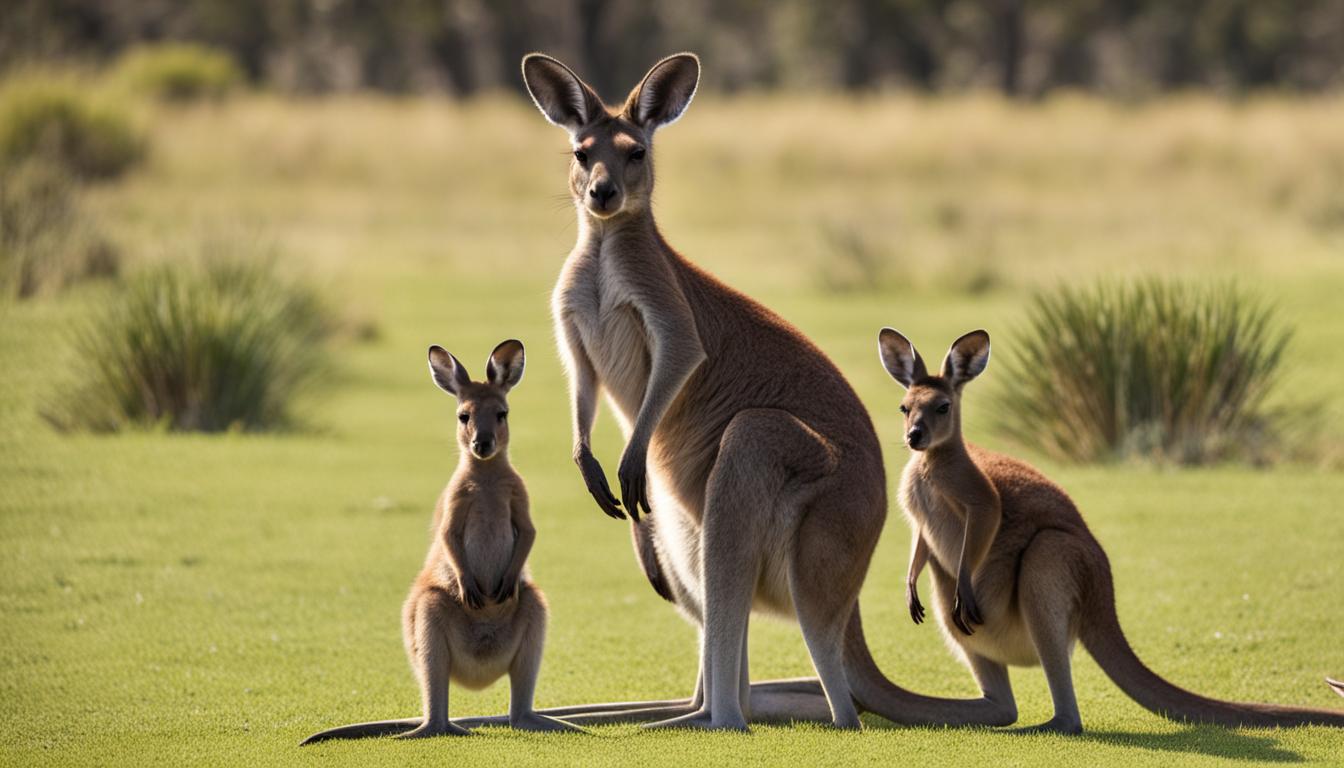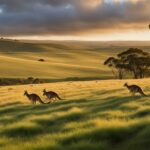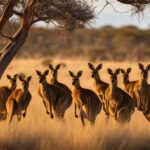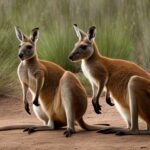When it comes to kangaroo family dynamics, there is a fascinating social structure that defines the roles of different family members within a kangaroo group. Kangaroos, particularly eastern grey kangaroos, are known for their highly social behavior, and understanding their social structure can provide valuable insights into kangaroo parenting and group dynamics.
In a kangaroo group, which is referred to as a mob, the core members are adult females with their young and juveniles. They form the fundamental units of social structure, ensuring the survival and well-being of the group. While adult males may have contact with female groups, their associations are loose and not long-lasting.
Interestingly, in some populations, male-female segregation occurs as males seek out the company of other males. This segregation contributes to the intricate social dynamics of kangaroo groups. The average group size is around 3 individuals, although it can range from 1 to 16. Larger groups facilitate shared responsibilities such as scanning for predators and more efficient feeding.
Within the group, dominance hierarchies exist, with size and age largely determining the ranking. These hierarchies help maintain order and ensure the smooth functioning of the group. The social dynamics of kangaroo groups can also vary depending on the season. During the non-breeding season, there is sexual segregation between males and females. However, during the breeding season, mating-related interactions increase.
Kangaroos engage in non-aggressive behaviors like touch, grooming, and social play, which strengthen social bonds within the group. These interactions contribute to the overall well-being and cohesion of the kangaroo family. So, the roles of different family members in a kangaroo group are crucial for their survival and success as a species.
Kangaroo Family Structure and Social Behavior
Kangaroo family structure is characterized by a matrilineal bond and extended family groups called mobs. Mobs play a crucial role in preserving the culture of kangaroo groups. Kangaroos have a loose “fission-fusion” social structure, with mobs often splitting and reforming. Kangaroos maintain strong attachments to their range, which is essential for their health and well-being as well as the health of the landscape.
Kangaroos contribute to the health of Australian ecosystems, although their ecological role is often overlooked. Kangaroos are highly social animals, and their relationships can be complex. Recent research suggests that kangaroo mothers become more social when caring for joeys, contrary to previous beliefs. Kangaroo relationships can be long-term, and some individuals maintain friendships across multiple years. Kangaroos’ loose social structure allows them to adjust their sociability based on their reproductive state.
Further research is needed to explore the existence of long-term relationships in kangaroos and why female kangaroos increase their sociability when they become mothers.
| Kangaroo Family Structure | Social Behavior |
|---|---|
| Matrilineal bond | Complex relationships |
| Extended family groups (mobs) | Adjust sociability based on reproductive state |
| Loose “fission-fusion” social structure | Long-term relationships |
“Kangaroos are highly social animals, and their relationships can be complex.”
Kangaroo Family Structure and Social Behavior
Kangaroos have a unique family structure where the bonds between females and their offspring are central. These matrilineal bonds form the foundation of extended family groups called mobs. Within these mobs, kangaroos exhibit a “fission-fusion” social structure, with members often moving between groups.
These social bonds play a crucial role in the preservation of kangaroo culture and the overall well-being of the individuals. Kangaroos have been observed to form long-term relationships, maintaining friendships across multiple years. This highlights the importance of social connections in the kangaroo community.
Recent research has also revealed fascinating insights into kangaroo social behavior. Contrary to previous beliefs, kangaroo mothers actually become more sociable when caring for their joeys. This adjustment in sociability based on reproductive state showcases the adaptability and complexity of kangaroo social behavior.
In conclusion, kangaroo family structure and social behavior are unique and dynamic. The matrilineal bonds within extended family groups create a strong sense of community and contribute to the overall well-being of kangaroo populations. Understanding these social dynamics is crucial for conservation efforts and appreciating the fascinating world of kangaroos.
Kangaroo Group Dynamics and Behavior
Kangaroo groups have complex dynamics and behaviors that contribute to their social structure and overall well-being. Membership in kangaroo groups is not fixed, with individuals frequently moving between groups. The core of a kangaroo group consists of adult females with young and juveniles, forming the foundation of the family interactions within the group.
Adult males may interact with female groups, although these associations are not long-lasting. In some populations, males form all-male groups, resulting in male-female segregation. This segregation within the kangaroo family system can influence social behavior and the overall dynamics of the group.
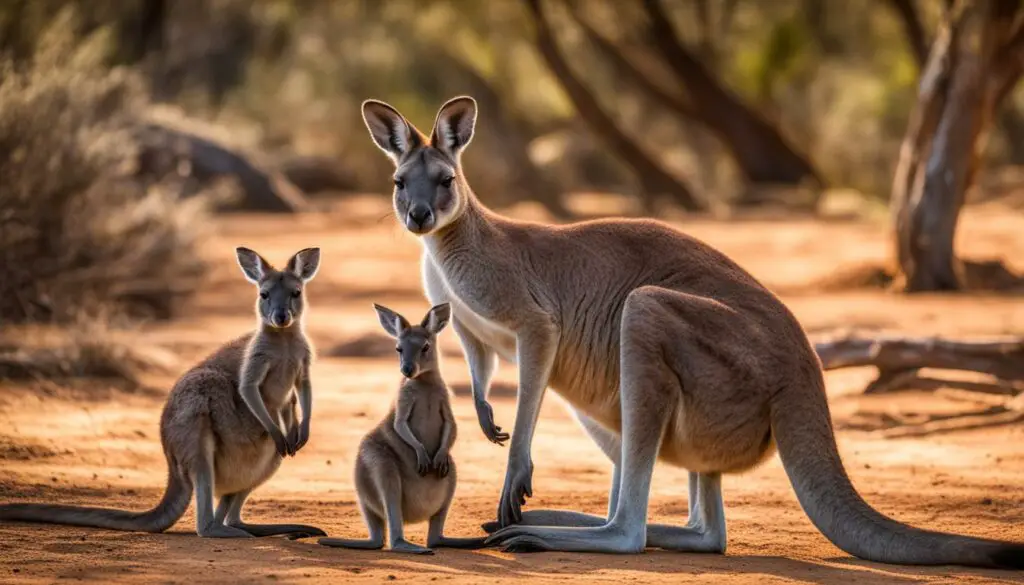
The Role of Dominance Hierarchies
Within kangaroo groups, dominance hierarchies exist, with size and age largely determining individual rankings. These hierarchies play a crucial role in regulating social interactions and resource access within the group. They help establish a sense of order and reduce conflict among group members.
Kangaroo interactions include non-aggressive behaviors such as touch, grooming, and social play. These behaviors help maintain social bonds within the group and contribute to the overall cohesion and well-being of the kangaroo family units.
The Importance of Group Size
Kangaroo groups can vary in size, with larger groups often forming around important resources such as food, water, and shade. While larger groups allow for better sharing of duties and increased vigilance against predators, they can also lead to competition and resource depletion.
The size of kangaroo groups is influenced by factors such as population density and habitat characteristics. In areas with higher population density and more open habitats, group size tends to be larger, reflecting the availability of resources and the need for increased social interactions.
| Advantages of Larger Kangaroo Groups | Disadvantages of Larger Kangaroo Groups |
|---|---|
| Improved ability to scan for predators | Potential for increased competition for resources |
| Shared responsibility for predator detection | Risk of resource depletion |
| Increased time for feeding | Higher risk of intra-group aggression |
The Significance of Kangaroo Social Structure
The social structure of kangaroos plays a significant role in their behavior and survival. Kangaroo groups, or mobs, provide a sense of security and belonging to individuals. Mobs allow for the sharing of responsibilities, such as scanning for predators and foraging for food. Group size can vary but is typically small, consisting of 3 to 6 individuals. However, larger aggregations may form around resources like food, water, and shade.
Table:
| Group Size | Benefits |
|---|---|
| Small (3 to 6 individuals) | Close social bonds, efficient scanning for predators, effective foraging |
| Large (aggregations) | Greater access to resources, potential competition and resource depletion |
The social structure also influences the behavior of kangaroos during different seasons. During the non-breeding season, sexual segregation occurs, with males and females not interacting as much. However, during the breeding season, males actively move around their home range to assess the reproductive state of females. The social interactions within kangaroo groups, such as touch, grooming, and social play, contribute to the overall well-being and cohesion of the group.
Quotes:
“Kangaroo groups provide a safe space for individuals to share responsibilities and resources, ensuring their survival in the wild.”
The Role of Group Size in Kangaroo Behavior
The size of a kangaroo group has a significant impact on its behavior and dynamics. Smaller groups allow for closer social bonds and more efficient scanning for predators. With fewer individuals, resource access and competition are generally well-balanced. On the other hand, larger aggregations provide greater access to resources, but can also lead to increased competition and resource depletion. The size of a kangaroo group is influenced by factors such as population density and availability of essential resources like food, water, and shade.
Lists:
- Small kangaroo groups:
– Close social bonds
– Efficient predator scanning
– Effective foraging - Large kangaroo aggregations:
– Greater access to resources
– Potential competition and resource depletion
As kangaroos adjust their sociability based on their reproductive state, the social structure and interactions within kangaroo groups are crucial for their overall well-being and survival. Further research is needed to explore the long-term relationships and social dynamics within kangaroo groups and their ecological role in Australian ecosystems. Understanding kangaroo social structure and behavior is essential for conservation efforts and fostering a greater appreciation for these fascinating marsupials.
Conclusion
In conclusion, kangaroos possess a fascinating family dynamic and societal structure. Within kangaroo groups, adult females with their young and juveniles form the core, while adult males may have limited contact with female groups. Group size can vary, with larger aggregations forming around crucial resources like food and water.
Importantly, dominance hierarchies exist within kangaroo groups, with individual rankings largely determined by size and age. Non-aggressive behaviors such as touch, grooming, and social play play a vital role in maintaining social bonds within the group, contributing to their overall well-being. These social interactions help to create a sense of security, fostering a strong and cohesive kangaroo family.
Understanding kangaroo family dynamics and societal structure is crucial for conservation efforts and gaining a deeper appreciation for these remarkable marsupials. Further research is needed to explore the long-term relationships and social dynamics within kangaroo groups, as well as their ecological role within Australian ecosystems. By delving deeper into the intricacies of kangaroo social bonds, we can better protect and preserve these iconic creatures for generations to come.
Do different family members have different roles in establishing social hierarchies within kangaroo groups?
Within kangaroo groups, each family member plays a unique role in establishing social hierarchies in kangaroos. Males compete for dominance and mating rights, while females maintain the group’s social structure. Young kangaroos learn these dynamics through observation and interaction, solidifying the social hierarchies in kangaroos.
Do kangaroo groups also have a form of communication and roles for different family members like cheetahs?
Yes, kangaroo groups also have a form of communication and roles for different family members like cheetahs. Cheetah communication in the wild plays a crucial role in coordinating hunts and identifying potential threats. Similarly, kangaroos use body language and vocalizations to communicate within their groups and establish social hierarchy.
FAQ
What roles do different family members play in a kangaroo group?
In a kangaroo group, the core consists of adult females with young and juveniles. Adult males may have limited contact with female groups. The females take on the responsibility of caring for the young while also contributing to the group’s overall security and well-being.
How does kangaroo family structure influence their social behavior?
Kangaroo family structure plays a significant role in the social behavior of these marsupials. It determines the membership within groups and the formation of mobs. The family structure also influences the behavior of kangaroos during different seasons, such as sexual segregation between males and females during the non-breeding season and increased mating-related interactions during the breeding season.
What are some key aspects of kangaroo group dynamics and behavior?
Kangaroo groups have complex dynamics and behaviors. Membership in groups is not fixed, with individuals frequently moving between groups. Dominance hierarchies exist within groups, with size and age largely determining individual rankings. Kangaroos engage in non-aggressive behaviors like touch, grooming, and social play, which help maintain social bonds within the group.
Why is kangaroo social structure significant?
Kangaroo social structure is essential for their survival and overall well-being. It allows for the sharing of responsibilities, such as scanning for predators and foraging for food. The size of kangaroo groups can vary, with larger aggregations forming around important resources. Understanding their social structure is crucial for conservation efforts and understanding their ecological role in Australian ecosystems.
What is the significance of kangaroo social bonds?
Kangaroo social bonds contribute to the overall cohesion and well-being of the group. These bonds are formed through touch, grooming, and social play. Recent research suggests that kangaroo relationships can be long-term, with some individuals maintaining friendships across multiple years. Further research is needed to explore the existence of long-term relationships in kangaroos and why female kangaroos increase their sociability when they become mothers.

